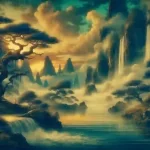During the years between the publication of the Arunodoi and the Jonaki, the literary output was small, and barring a few exceptions was neither creative nor inspired. Yet here we find how most of the writers have managed to break the hold of the Vaishnava tradition of literature. Western influence made Assamese literature more humanized and gave the language greater tangibity. Thus the greatest effect of the West was the emancipation of our literature from the religious discipline of the bygone days. Literary activities gradually grew both in volume and quality and received an added impetus with the restoration of Assamese, bringing in its train the urgent need of writing textbooks.
Much spade work had been done in the meantime. The Arunodoi inspired publication of other journals and newspapers. In 1839 the first Assamese grammar was prepared by a missionary at Serampore. Other grammatical notes followed. Then came the dictionaries. The publication of the Hem Kosh (1900) gave the chaotic spelling some form. The missionaries again showed the way by collecting and publishing some old texts. The Kirton Ghosha was published in 1876, followed by some great works of the Vaishnava and Pre-Vaishnava periods. These publications brought in their wake historical research and literary criticism. Gunabhiram Barua tried to write a history of Assam on modern principles. Ratneswar Mahanta focused on some points of recent history.
About this time the essays- literary, formal and personal- made its appearance on the scene. In the pages of the periodicals it was devoted to literary criticism, history, biography, Science and moral observations. It will be wrong to say that there was no tradition of biography. The Western impact only made the biography more systematic and accurate. In a critical note Ratneswar Mahanta, a nineteenth century pioneer, described the traditional biographies or Charit Puthis as ‘a basket of stories’ curiously blended with fact and fiction. He praised the handling of facts by the biographer Nil Kumud Barua in his Jibanadarsha, a collection of biographical sketches of some eminent Assamese. Thus a new sense of biography developed. Mahanta did not speak well of the biography of Dhekial Phukan written by Gunabhiram Barua. But the biography as a literary form had a quick development, and the literature has been enriched by several memoirs, autobiographies and diaries written by the stalwarts in the literary and other fields. In satire and travel accounts Gunabhiram showed the way.
Coming to the drama, we find that the Ankiya Nat still flourished but under the Western impact, notably that of the plays of Shakespeare, the new drama came and stayed on. The Shakespearean model was generally adopted with all its techniques. The comedy of Errors took its Assamese shape as Bhramaranga (1888). Most of our early modern playwrights had little sense of the theatre. They simply wrote in order to fill in the void. They often imitated the Western models closely. Still, several stageworthy plays were written for the amateur theatre. Plays on mythological and historical themes remained popular with our authors for several decades afterwards. But serious plays with social themes and forces also developed side by side. Later on, from the fourth decade of the twentieth century the influence of the Western theatre further widened with the application of the forms and techniques of modern playwrights of Europe and America including Ibsen, Shaw, Tchekov and O’neil. The influence of Brecht is the latest.
Two new growths in prose as a result of the Western impact in the nineteenth century were the novel and the short story. Both the forms quickly developed. The Grim brothers of the nineteenth century inspired Lakshmi Nath Bezbaroa to collect and publish Assamese folk tales. In his writings the short story came of age. Some of his short stories appear to baffle critics like Homen Borgahain, himself an excellent story teller. A conscious writer Bezbaroa knew what he was doing perhaps he tried to apply the techques of the Assamese folk tales (Sadhu Kathas) to the Western from of the short story and stumbled occasionally. Through a process of trial and error the short story soon established itself in variety of form and content. Western Story-tellers like Maupassant and Tchekov came to influence the short story in later ages.
In the novel also Assamese writers took up the form ready made. We can trace only a stage of upakhyan in the growth of the Assamese novel. If we ignore the translations and Padmavati Phukanani’s Sudharmar Upakhyan, Padmanath Gohain Barua, Lakshminath Bezbaroa and Rajanikanta Bardoloi can be taken as pioneers in this field. In their novels they leaned heavily on Assam history. Bardoloi has admitted his indebtedness to Sir Walter Scott and Bankim Chandra. The lays of Scott also shaped some Assamese ballads of the nineteenth century. Later on, the novel passed through a period of social consciousness and the exploration of the mind. Here too we find the influence of modern trends in the West.
Another off shoot of the Western influence was the growth of literary criticism. Some historians go back to the days of the Arunodoi to trace it. Yet it was a later growth. It flowered with the Jonaki. It is found in the essays of appreciation of the works of Sankardeva and other Vaishnava poets. Here also English supplied the models and techniques. Anandaram Barua, the great Indologist of the nineteenth century, applied Western methodology to the assessment of Sanskrit literature. To a collection of his own poems Ratneswar Mahanta prefaced a few lines on rhetoric and prosody. Here we find traces of English influence in his attempts at the classification of poetry. Apart from that we get little significant discussion on the principles of criticism, Indian or Western. Yet in the pages of the Jonaki literary criticism on Western lines grew steadily. Publication of old texts pioneered by Haribilas Agarwala, Madhav Chandra Bardoloi and others, and kept on by Hem Chandra Goswami paved the way for textual criticism.
Notwithstanding the spectacular growth of prose, poetry continued to be the dominant force. Here the Vaishnava tradition went on for some years but the new poetry took on a new direction. Western influence first came by way of Bengali. First came the short lyric including the sonnet and the blank verse. Nidhi Levi Farwell, a transitional poet, wrote Christian Poetry in old Assamese diction, but his contemporaries could see the immense potentiality of the blank verse used by Madhusudan Dutta, a great admirer of Milton Amongst the Assamese poets Bhalanath Das, Rama Kanta Chowdhury, Ratneswar Mahanta and Padmanath Gohain Barua used the blank verse. In their writings the lyrics- some of them really inspired- appeared for the first time. Some nature poems had a far-reaching influence. But blank verse was the craze though it was little more than imitative. The poets of the pre-Jonaki period and some poets of the next showed a preference for the epic form which they could not handle properly. The sonnet also received its share of enthusiasm. Hiteswar Barbarua, who used the blank verse in his Kavyas, had two volumes of sonnets to his credit.
The publication of the Jonaki ushered in an age when Western literary influences became direct and clear. The Jonaki created a new literary trend which was greatly felt in poetry. Here the main influence was the English romantic poetry of the nineteenth century. A vigorous romantic movement started first in poetry under the leadership of Chandra Kumar Agarwala, Hem Chandra Goswami and Bezbaroa. It continued to shape poetry, even the drama and the novel well into the middle of the twentieth century. About that time a number of English lyrics and descriptive poems were translated into Assamese. A number of historical plays in both prose and verse appeared. The romantic movement was so strong that it took diverse channels and flowed into the first four decades of the twentieth century with its vigour not much impaired. Further influence, both Western and Indian, was to bring a period of transition in the forties. The break with the romantic past became more or less complete after the Second World War when the new poets were greatly influenced by the Western imagists in form and socialistic ideas in attitude. The search for the Assamese identity assumed a new form. The poets suddenly became aware in practical and symbolic way that they lived in a wide world where national frontiers cut across each other at least emotionally. A new humanistic movement based on new ideas of Science, justice and human dignity took root in contemporary poetry. The blank verse and old metres are now fighting a losing battle with free verse. Yet in the writings of some living poets we still hear the echo of the Jonaki poets and their immediate successors. Meghram Pathak and Atul Chandra Hazarika are trailing along the old path alone.
Thus the impact of the West through English in the nineteenth century gave Assamese literature a certain new shape and direction. This dose not mean that our literature has always depended on outside inspiration. Yet we cannot wish away the fact that Assamese writers have continued to profit from the ideas and movements in the West. English still serves as the window on the world. Western forms, techniques and attitudes have shaped the short story and the novel in the thirties. After the Second World War Assamese poetry took a new direction under the impact of Marxism and Western literary trends. The sixties saw a movement which popularised the one act play and established its standard. Now the influence of Brecht reigns supreme in the drama. New Criticism has had a salutary effect on literary Criticism of these days. Some stalwarts in this field are creative writers with a wide and deep vision.
The world has grown small and now we have a kind of ‘World Culture’ often lamentably degraded to the level of cheap and shallow mass culture. On the popular side this new culture has imported much of the restlessness and violence which have crept into our recent writings. This new trend is mostly found in fiction and the drama. The popular magazines print hair-raising spine-chillers like those of Hitchcock, ghost, monster and science fiction stories. The comic strips have appeared to complete the picture.
The Impact of the West on Assamese Literature
Author : Sunil kumar Barthakur
Author : Sunil kumar Barthakur
3 responses to “The Impact of the West on Assamese Literature”
-
nice write-up..comprehensive
regards
stuti goswami
-
A very informative piece of work.
-
very informative piece of work.



Leave a Reply